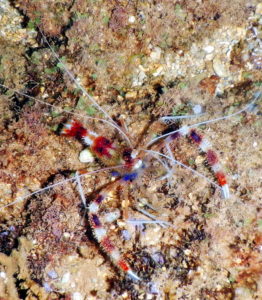
September 6, 2021
Last Monday, Labor Day, I visited a couple I haven’t seen in a while, and I worried they may have passed away. But when I peeked in their doorway, there they were, perky as ever as they stepped out to greet me. My old friends are a pair of banded coral shrimp.
Also called barber pole or peppermint shrimp after their red-and-white-stripes, the shrimp usually hang upside-down on the ceilings of the reef holes they call home. (I’ve flipped all my photos here to show the shrimp right-side up, but I nearly always find them upside-down.) These and all shrimp have 10 legs, the front pairs usually large for grabbing food, the smaller rear pairs for walking and gripping surfaces.
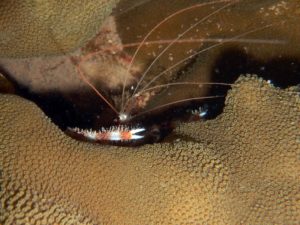
To find banded shrimp, fish and eels (and snorkelers ) look for the shrimps’ white antennae, so long they nearly always stick out of the shrimps’ dwelling. The shrimp wave these antennae like flags to let their clients know they’re open for business. Although banded shrimp are more active at night, they work days too. ©Susan Scott
The banded shrimps’ trade is pest control and wound debridement. The shrimp picks and eat parasites from fish and moray eels, and also devours pieces of tissue dangling from injuries. Usually, shrimp are food for fish, but as payment for their services, the shrimps’ carnivorous clients don’t eat them.
When parasites or injured flesh aren’t available, the shrimp scavenge around their neighborhood, eating anything they find, dead or alive. That’s why during my approach, rather than backing into their home to hide, the shrimp step toward me, checking to see if I’m crawling with vermin or dangling damaged skin.
Even with built-in protection, the shrimp, like most reef creatures, live on the edge. Last year, I found one of my shrimp missing one of its large front claws. This is a common occurrence since banded shrimp can drop a claw if trapped or stressed. The claw grows back after a molt or two.
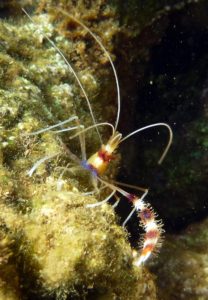
The front claw of one of my shrimp was missing last year. It has since grown back. ©Susan Scott
Banded shrimp are nearly always found in pairs, choosing a mate when young and remaining faithful for life. The couple is territorial, never venturing more than a few feet from home, and fighting other banded shrimp that have the temerity to trespass. Mated pairs are devoted, grooming one another, guarding each other during molts, and when the time is right, performing courtship dances that end in mating. Females carry her blue eggs on her belly, the mass held there with tiny claws.
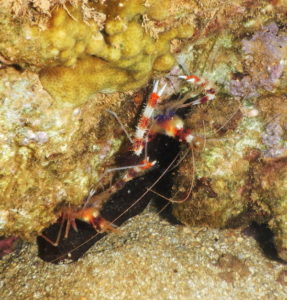
Pairs remain together for life. Note the lower shrimp is missing its left front claw. ©Susan Scott
I’ve been visiting this pair of banded coral shrimp since 2017 after I saw one inching toward a turtle sleeping under a large coral head (below.) Later I found the couple’s nearby coral cave . In aquariums, this species can live five or more years. Life is harder in the wild, but being at least four years old, my shrimp obviously live in a safe neighborhood with ample food.
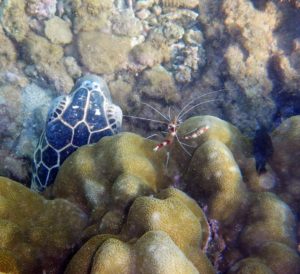
One time, I watched one of the shrimp approach a baby spiny lobster, tucked in a crack of the same coral head. Careful! I thought as the shrimp approached. Lobsters eat shrimp.
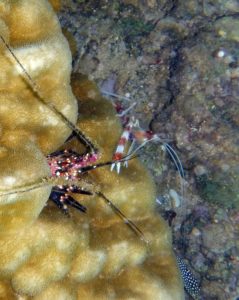
The next time I visited, however, the shrimp pair were safely nestled in the apartment they share with a yellow-margin moray eel. The young damselfish at the top of the picture below seemed unafraid of the eel. On coral reefs, miracles never cease.
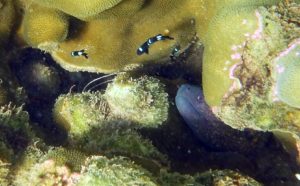
Banded coral shrimp bodies grow to about two inches long, but their wiry antennae make them three times that. The species is found around the world’s coral reefs from shallow water to 100 feet deep. The shrimp are common on Hawaii’s reefs, and the ones with successful setups, such as the two that homestead near the end of my snorkeling route, can be visited and enjoyed for years.
Finding this charming couple alive and well in their fourth year of life made my Labor Day holiday a positive one. During these scary and depressing times, I needed that. Thank you, little shrimp.
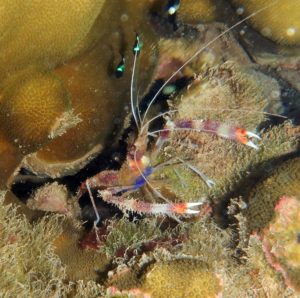
My shrimps’ colors looked faded last week-end, perhaps the sign of an impending molt. Banded coral shrimp molt every month or so, depending on diet, health, and stress. This is the female carrying her blue eggs. © Susan Scott